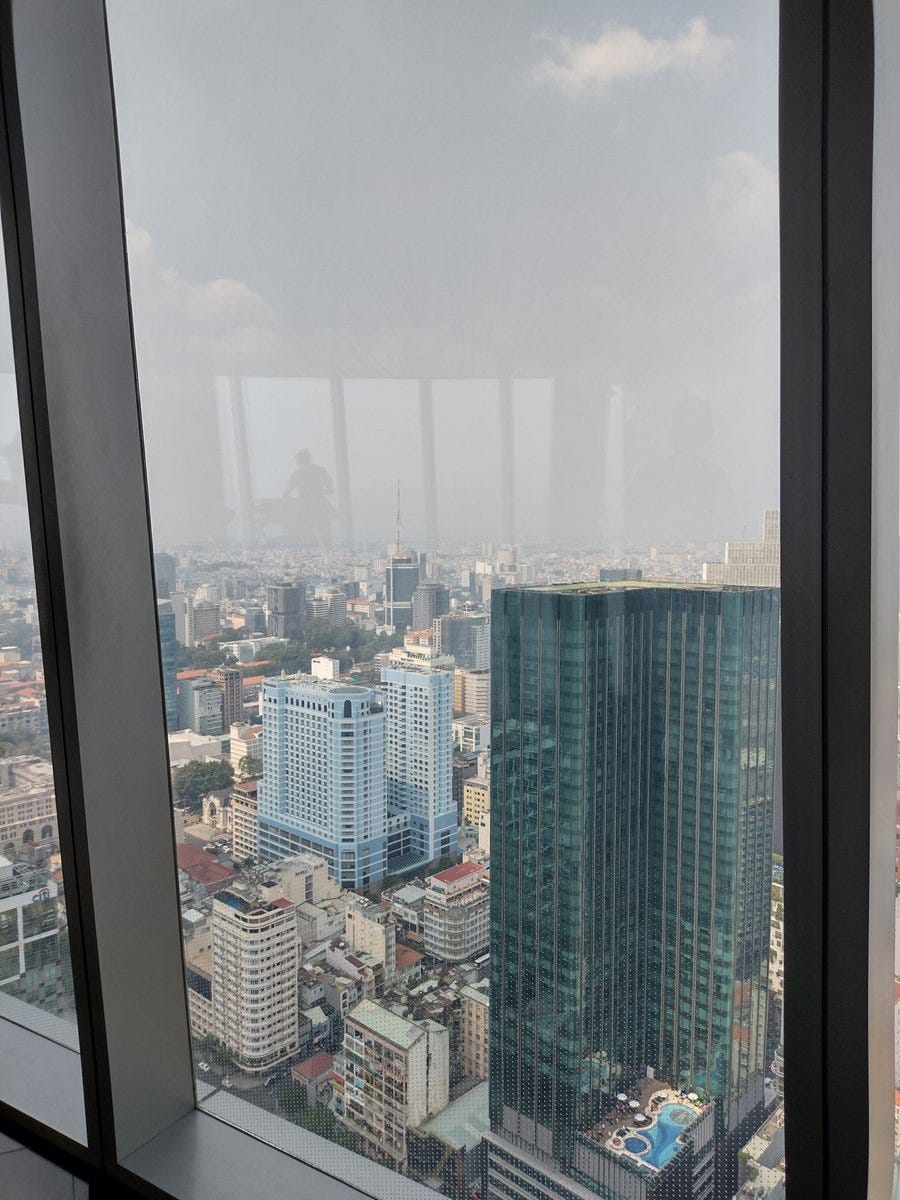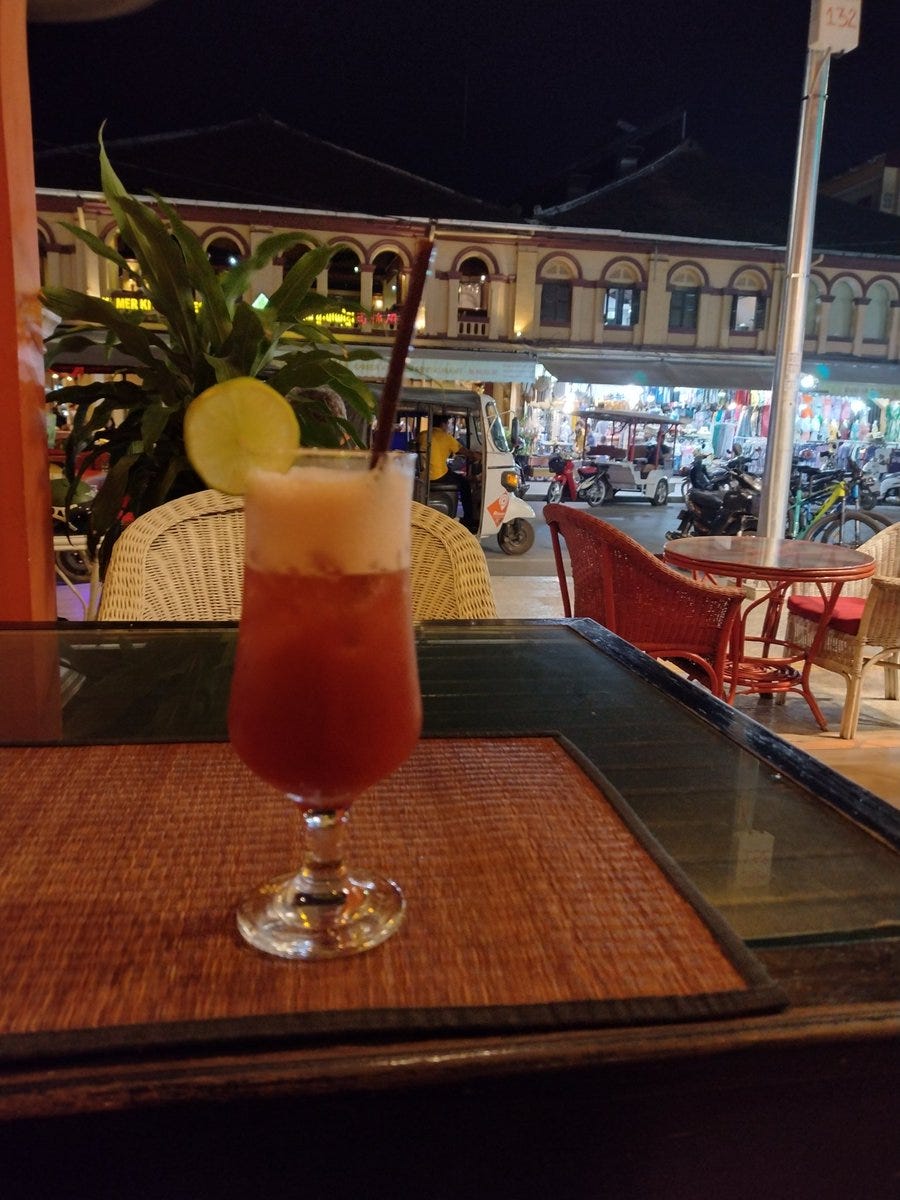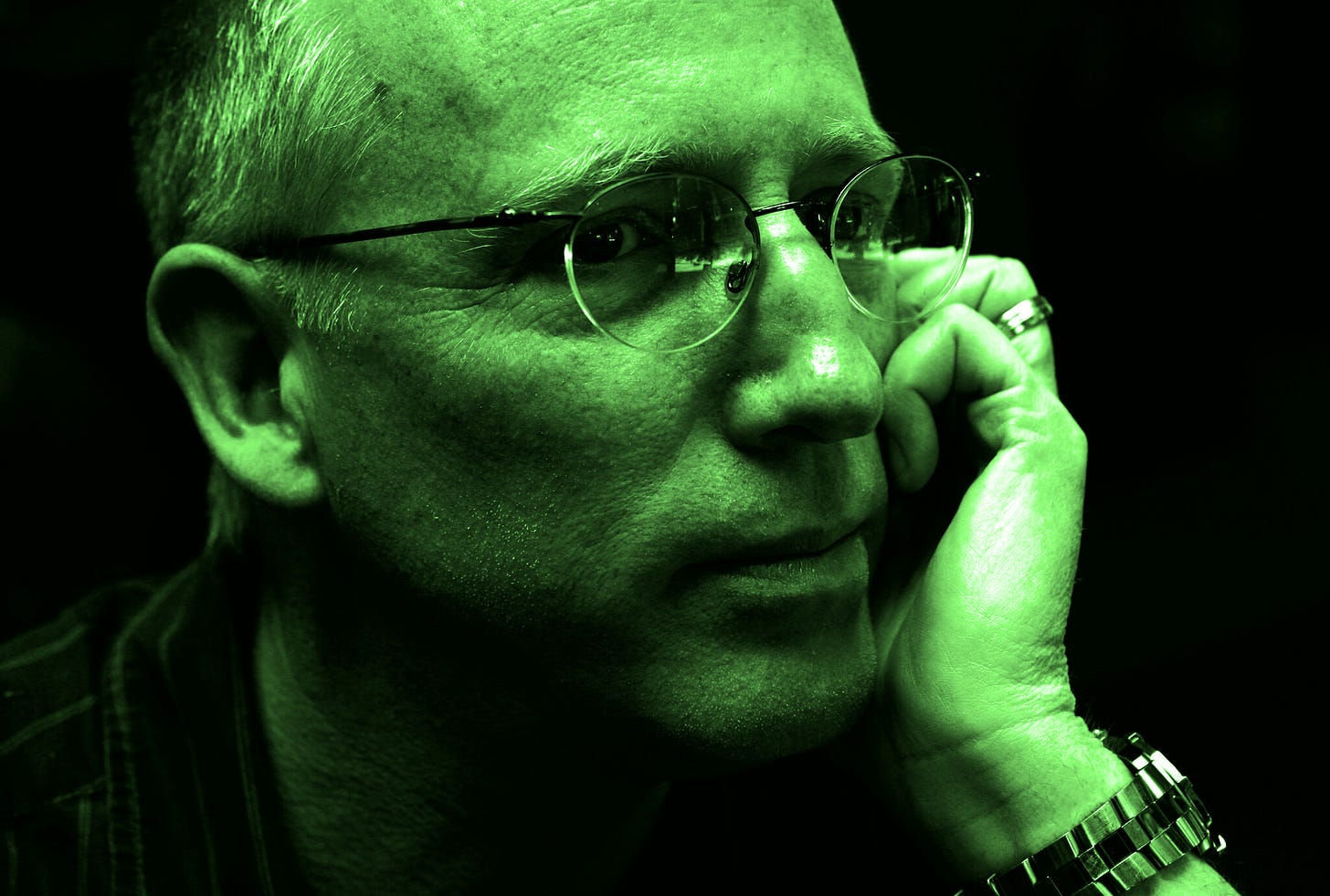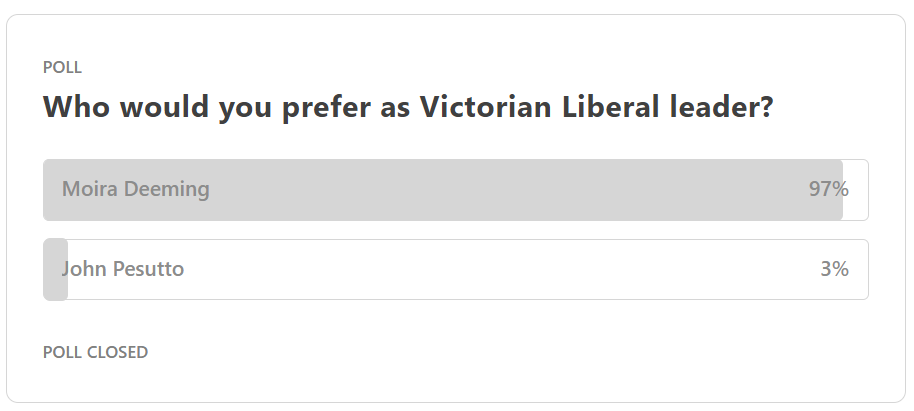Eye-Opening Dispatches From Vietnam
After three long years of covid lockdown-induced solitary confinement, a loyal Liberty Itch subscriber cut loose, left Australia for South-East Asia and found herself in Vietnam.
Animated by what she saw, I started to receive her much-welcomed dispatches about daily life there.
Now, if you read any 1960s and 1970s history, you know Vietnam is communist. But what my friend’s streetscape dispatches reveal is that daily life is anything but centrally-controlled. In fact, what she witnessed felt more like the hustle and bustle of enterprise or, as our intrepid adventurer pithily described …
“official communism, sure,
yet with a je ne sais quoi libertarian, freewheeling spirit,
small-scale capitalist at every turn.”
I’ll step out of the way. These are her words …
There are no rules, Kenelm. It’s fend for yourself. Even these communists realise capitalism is the way to go. Free markets and small business. It feels like what I imagine 1880s London or 1980s Hong Kong to be. Free. Laissez faire. Taxes are low. 5%+ for residents. 20% flat tax for foreigners. The communists simply don’t have the money for bureaucrats. They’ve taken themselves out of the game and let people live their own lives.
There’s genuine economic development here. It’s booming.

There is little of government here to save you. You save yourself or drown, which isn’t an option.
So, family is very important. Your family takes care of you in your old age, not the government. You know, like we used to do in Australia.
Prices are so low.
Petrol is a mere 37 cents a litre. No fuel excise. Can you imagine?
Food is cheap.
At the end of a long, hard day, cocktails are $2.50.

Road rules? The only rule here appears to be there are no rules, almost anarchy. Yet it works. A loose framework exists where thousands stop on a red light. But only when it suits them. Lanes on the road? Only use those if you absolutely must. It’s better to weave right, left, and even preferrable to pit your life against a semi-trailer coming from the opposite direction, because you absolutely must overtake the vehicle in front of you.

Pedestrian crossings? A mere piffle, an abstract idea where someone thought stripes of white paint were to beautify the road. The pedestrian who stands at one end expecting the traffic to stop for her, hah! She is the pedestrian who never returns home alive. As one local said to our observer, “If you don’t move, you’ll die. You need to move. Not too fast. Not too slow” … to which I replied, “Oh, you mean the Goldilocks effect”. The harrowed local muttered “Who is Goldilocks?” under his breath. Big tip! It’s best to wait for a small gap in the traffic. Walk whilst praying to God the entire time that He will see you safely to the other side.
Footpaths? You know, for human feet? A figment of an idea, I tell you. They are just another lane for bikes to scoot down in the gridlocked peak hour traffic. Footpaths are places to park, to open your front gate, to wheel your dolly-trolly, to sell your wares for the day. All day and every day. The pedestrians are after-thoughts.
Did I mention $3 Singapore Slings?

There aren’t suffocating regulations about, say, straws. Yes, you can get a decent plastic straw in Vietnam!

Communism, lurking in the background somewhere, OK. But the streetscape looks what I imagine laissez faire to be. It’s a rambunctious, rollicking, throbbing freedom, not that poor imitation back home. It’s every man for himself. As the saying goes, “It’s the quick or the dead” around here. Maybe that’s because the communists simply can’t make central planning work to feed people. Maybe they gave up that aspiration long ago. Everyday people her feed themselves and their families through good old-fashioned free trade.
This is what Australia is competing with! Enterprising, self-reliant people. Low prices. There’s a lot of manufacturing being exported. They value add. It’s not a big quarry like other economies we’re familiar with!
The West is on the precipice of losing something incredibly precious.
In comparison to Vietnam,
we need to wrap society in cotton wool
and legislate for every possible scenario that might make us sick, kill or injure us.
We’ve left the realm of common sense, we’re stifled and soft-pruned by a socialist bubble bath. Individuals can no longer assess risk with any degree of rationality. Individuals are increasingly absolved of all self-responsibility and that power is being placed into the hands of faceless bureaucrats and legislators who make decisions on our behalf. It’s not needed. It’s not in our best interests. Vietnam proves it.
Remind my fellow Liberty Itch subscribers, as I often remind my friends, none of us are getting off this planet alive! We need to take back our autonomy, before it’s too late.
To all of which, I can only say to my friend, hear hear!
3 Horrifying NSW election predictions
Tomorrow, New South Wales voters will choose their next government.
The winner will be the Liberal-National incumbent or the Labor insurgent.
At this point, no other party is strong enough to usurp either. They are the only options to form government.
The Liberal-National Coalition has been in power since 2011. In 12 years, they have had Premiers Barry O’Farrell, Mike Baird, Gladys Berejiklian and Dominic Perrottet. The second resigned at the top of his game and is now a middle-level manager of a bank. The first and third resigned under an ICAC cloud.
Under it’s leadership, transport services have improved dramatically. Hospitals have been adequate. School results have slowly diminished. It’s handling of covid was relatively light-touch at first, but Gladys Berekijlian requested that troops be deployed in Western Sydney to enforce covid restrictions and the Ruby Princess matter was a debacle, her government accommodated the slide towards the illiberal in education, much needed land releases were held back to keep real estate prices high, and much talent vacated the capital, Sydney.
Further, the Perrottet Government has veered dangerously towards a green tape business culture. In the dying days of this campaign, the Premier has flip-flopped on whether to keep Eraring Power Station. Debt has skyrocketed. It will take generations to repay the damage. Over the years, the clear stars have been Mike Baird and Andrew Constance, both now gone, as well as Victor Dominello who is still there.

The Labor Opposition has distance from the Eddie Obeid days. Chris Minns is a relatively unknown as Opposition Leader. He is certainly economically illiterate, not being even able to articulate a fully-funded first year budget. However, he performed the bells and baubles hustings game well in a presidential-style campaign before a friendly media. He had to do that because his shadow cabinet is obscure and without experience. On last count, there is not one MP in opposition with employing small business experience. On policies, they will certainly ramp-up the debt. But that is a bi-partisan policy.
I am ill-at-ease for my New South Welsh cousins.
They really have a tweedledum and tweedledee choice before them in terms of who forms government.
If I were a betting man, and on politics I am not because for me democracy is not a devalued commodity of a crap shoot or two-up round, I would suggest to the readers of Liberty Itch that both options represent higher taxes and lower personal freedom. I could recommend neither to you, and I am a former Young Liberal of the Year and State Executive member of the NSW Division of the Liberal Party in the 1990s.
No-one can predict the future and my track record is woeful, though I was correct with my Stunning Early Victoria Election Prediction.
However, at 6:54pm ACDT on 24 March 2023, I make three election predictions as follows:
Prediction #1: Labor will win!
Prediction #2: Labor will form majority government.
Prediction #3: Liberal will win the Legislative Assembly seat of Hornsby.
To be clear. I do not wish these results. I do predict them.
This will mean the Liberal-National Coalition will form no government on mainland Australia.
It will also mean that the Liberal-National Coalition will likely continue its current trend to electoral oblivion.
The support base for the Coalition is cleavered on the issue of climate change. It is an issue which has been fraught for many Liberal leaders for a decade. It is the equivalent of the DLP split from Labor in the 1950s which kept them out of power for twenty years.
What is for certain, NSW needs a government which keeps away from our bank accounts and out of our private lives.
It will be some time before that is a reality for the good folk of New South Wales.
CAPTION THIS: What is Malcolm Roberts Thinking?
Yesterday’s antics from “Senator” Lidia Thorpe were AOC-esque in their immaturity. This, we have come to expect from her as she blesses us in her last term.
Little comment has been made that the woman standing next to the grovelling senator is the unyielding Senator Pauline Hanson (PHON, Qld), identified by her black and white shoes.
But who’s that fella behind the female police officer’s arm with the orange tie?
None other than the industrious Senator Malcolm Roberts (PHON, Qld).
Caption this photo. Just what is Senator Roberts thinking? Yes, Senator Roberts.
(Restrict your caption to 5 words or less.)

8 Segments of the Democratic Right
Here’s the quick political segmentation for you to ponder.
The Australian political landscape has two overarching groups: the Extremists and the Democrats.
We must actively counter the Extremists in the public square regardless of their form or stripe. No exceptions. No nuancing or qualifying. Their idealogies are all abhorrent. This includes five sub-groups: the Communists and Socialists, the Fascists and Ethno-Nationalists, and the Militant Jihadists as well.
We don’t weaken our democracy by banning them.
No! As Democrats, we must do the hard yards engaging and countering them.
We expose their dire histories, their graphic, heinous results, their intolerance, ulterior motives and their totalitarian DNA. We reveal and mock, we eviscerate and make them look odd and utterly untempting.
We built alliances among the Democrats in this regard, we unite with them against the Extremists and focus our message towards the disenfranchised, marginalised and dispossessed so they don’t drift to the Extremists.
As and once we win, we turn next to our fellow Democrats. With our democratic fellow-travellers, we reason and convert.
Now, inside the Democrats, there are two sub-groups both with long and proud traditions. They are the Democratic Left and the Democratic Right. As the names suggest, both are democratic but of different flavours. Both are ice cream, just one is strawberry and the other chocolate. Here the flavours are more government and more freedom.

We start with our great democratic opponent, the Democratic Left. This group comprises the Social Democrats with their penchant for the welfare state in the name of compassion. They are fairly united right now, sitting inside the Australian Labour Party, the Australian Greens and Animal Justice and representing a cohesive, fighting force. If we do not impune their motives but show them the results of their policies, we might have a chance. Far more effective is that we promote policies which contrast, wedge and split them. AUKUS is emerging as a wedge issue for the Democratic Left.
History suggests it will be hard to convince them. And if that be the case, so be it.
Next, we must strengthen the Democratic Right for future battles.
So what do we discover?
Well, the Democratic Right are highly fragmented at the moment. In fact, there are 8 segments, all fairly distinct sub-sub-groups if you look hard enough but with some smudging at the edges which reveals affliation across some of the grouping and that people migrate between them.
Here are the 8 segments:
- The Moderates
We’re talking here about people who self-describe as small-l philosophical liberal or modern liberal. Moderates see themselves as fiscally responsible and socially liberal. Since 2007, if loyal party members, this segment hasn’t noticed they are frogs in the slow-boiling saucepan fiscally. If new to party politics, the ranks of the Moderates now include people who have a tendency to be big government spenders rather than economically lean, and that expenditure has often been on social projects they wouldn’t have chased in the Howard years. We are talking about Liberal Party members and Teals. - The Libertarians
This group, most likely you as a reader of Liberty Itch, sometimes self-describe as classical liberal or liberal. Like the Moderates, they see themselves as fiscally responsible and socially liberal. Unlike the Moderates, the Libertarians are philosophically-driven and so their policy prescriptions are consistent and predictable. And they are very dry fiscally, to the point of reducing the size of government. This sometimes results in a doctrinaire approach and an obsession for philosophical purity tests. We are talking members of the Liberal Democrats. - The Disaffected
These people are probably ex Liberal Party supporters, probably slow to leave, currently political refugees, probably moderate, probably white collar, and looking for a new party which expresses their values. They are confused and disoriented. They are upset. They feel the political rug has been pulled from under their feet. - The Populists
Here, we’re talking probably about former Liberal Party members who self-describe as conservative but, on closer scrutiny, their views taken in total show a mixed or inconsistent framework. This inconsistency can sometimes cause them to err into dangerous territory and be drawn to a charismatic leader. They are mostly blue collar, and have already migrated to One Nation and the United Australia Party. - The Conspiracy Theorists
This segment doesn’t know which political party they belong to, are skeptical of authority, and yearn to make sense of the world. They frequently latch onto theories about globalists and global bodies but, with emerging critical reasoning skills only and craving certainty in an uncertain world, cannot discern between fact and fiction. You can find these people in any of the parties but they are particularly concentrated in Australia One and the sovereign citizen movement. - The Agrarians
This segment lives in rural areas or regional towns with a strong agricultural influence. They are conservative, but fiscally slip into protectionist economics and bigger spending rural services. They are in the National Party, Liberal Party and the Shooters Fishers and Farmers. - The ConservativesAs I’ve documented, conservatives love to conserve whatever the status quo of the day. Since resistance to change is their modus operandi, the work tirelessly to halt or slow undesirable change. However, Conservatives rarely come up with new policy themselves and what they do come up with can be anti-freedom. Think bans, quick-to-judge court proceedings and higher taxes to fund conservative causes. This puts them on the back-foot constantly for lack of policy flair. You’ll find conservatives and self-described conservatives everywhere.
- The Christian Right
This segment has no monopoly over right-wing Christians. The difference between the Christian Right and all other Democratic Right segments is that it is exclusively Christian and it seeks to assert Biblical authority into the state as a kind of theocracy of one potency or another. The other segments mentioned will assume a plural, secular, liberal democracy. The Christian Right is usually evangelical or orthodox, usually Pentecostal, always family-oriented. You will find members in Family First and the Australian Family Party.
The challenge for the Democratic Right is to bind these 8 segments to form a Centre-Right Coalition, win against the Democractic Left and put the Extremists out of business.
SENATE LIVE: Nuclear energy debate from the Senate floor now …

LIVE DEBATE
Live now from the Senate floor, Senator Ralph Babet (UAP, Vic) raises ‘matter of interest’ … removal of Australia’s prohibition on nuclear electricity generation.
The Senator in full flight. An historic speech. Watch live now …
https://www.aph.gov.au/News_and_Events/LiveMediaPlayer?vID=%7B5BBCDCF5-4A0C-4A05-86CF-EE872069FBD9%7D&type=1
HISTORY
Nuclear energy prohibition started to emerge as a possibility in the old Hawke, Nuclear Disarmament Party days in the 1980s.
However, the nuclear energy prohibition actually came into being on 10 December 1999. The Howard Coalition Government was seeking to have a new nuclear research reactor built at Lucas Heights, Sydney. Labor was opposed so the Liberals and Nationals turned to the Australian Greens for support. The Greens said ‘yes’ if the the Government would support a prohibition on nuclear electricity production. In the absence of any nuclear power plants being constructed, the Howard Government agreed, Lucas Heights was built and the general ban instituted.
The debate in the Senate lasted 10 minutes!
On 28 September 2022, Senator Canavan (LNP, Qld) delivered a second reading speech for Environment and Other Legislation Amendment (Removing Nuclear Energy Prohibitions) Bill 2022 calling for the nuclear energy prohibition to be lifted. This amendment was not carried.
Senator Babet continues the fight.
SENATE PROCEDURE
Time for “Matters of Interest” speeches are allocated proportionally to political parties on the basis of the seats held.
The United Australia Party has one senator of seventy-six, or 2% of the time available. As the sole senator for his party, Senator Babet receives all of that time.
It is worth noting therefore that senators of the majors only receive “Matters of Interest” time at the whim of their party leadership. Liberty Itch imagines this adversely affects Senator Matthew Canavan (LNP, Qld), Senator Gerard Rennick (LNP, Qld) and Senator Alex Antic (Liberal, SA).
The Colonial Mindset
In the Spanish-speaking countries of Latin America, people speak of the Spanish conquistadors as them. They invaded us, they murdered us.
This allows populist leaders to frame the entire historical narrative of the region as a story of oppression, blaming their countries’ current misfortunes on the atrocities of colonisation; 200 years on.
If blaming the Spanish Empire for the ex-colonies’ abysmal levels of poverty in the 21st century is not enough, the populist turns to the US Empire to explain away the misery. It is a crippling mentality promoted by corrupt leaders who benefit from keeping people down while avoiding responsibility for their own failures.
Blame: a crippling mentality promoted by corrupt leaders.
It’s the perennial revolution that goes around in circles promising to avenge the poor, only to enrich the revolutionaries.
White Australians, on the other hand, tend to identify with the English colonisers and blame themselves for colonial crimes against Aboriginal people. We invaded them, we took their land.
As a migrant to this country, I cannot share in this historical guilt.
Am I contributing to Australia’s cultural diversity as a productive member of society or am I an invader? Which one is it?
More importantly, has this pathological guilt done anything to improve the living conditions of Aboriginal Australians or has it been exploited by professional meddlers that make a living out of Aboriginal disadvantage?

Blame and guilt are two sides of the same colonial coin. Nothing good can ever come out of playing the blame game. Guilt, however, can be a healthy societal response to painful moments in our shared history. It can serve as a reminder of the importance to uphold an ideal of justice based on the natural rights of all peoples. This would be conducive to genuine compassion, appreciation, integration, and mutual respect.

Sadly, this constructive voluntary response is perverted with the institutionalisation of a collectivist mindset that classifies people today based on events that occurred before they were even born.
Once the state starts to treat people differently based on their race,
all hope of reconciliation is lost.
The very idea that some people are incapable of improving their own condition without the condescending guidance of a centralised authority is an insidious form of neo-colonialism.
This isn’t to deny or ignore history. On the contrary, this is to look at history carefully while keeping your eyes wide open in the present.
Imagine for a moment a white Australian man that finds himself on the streets after a series of calamities destroy his former life. He struggles for a long time but finally finds the strength to pick himself up. He goes to a job agency but the only opportunities available are open exclusively to Aboriginal people because the agency has to meet a quota to receive extra funding.
Is this just the price that he has to pay for the crimes of his ancestors (who could have been great advocates of aboriginal rights for all we know)? Is any and every Aboriginal person inherently more deserving regardless of their own actions in the present simply because of what happened in the past?

Like the poor in Latin America, Aboriginal people in Australia need individual agency over their own lives, with economic opportunities to thrive and prosper, not perennial displays of contrition and a bureaucratic melee that costs a lot (for the benefit of public servants and consultants) but delivers nothing.
In 2010, the Department of Finance’s Strategic Review of Aboriginal expenditure concluded: “The history of Commonwealth policy for Indigenous Australians over the past 40 years is largely a story of good intentions, flawed policies, unrealistic assumptions, poor implementation, unintended consequences and dashed hopes.”
For many in the Indigenous Industry that are now enjoying a comfortable retirement, this has been 50 years of money well spent.
The Voice and the apparatus that would support it are manifestations of the same colonial mentality that sees Aboriginal people as a problem to be solved rather than equal citizens in pursue of their own happiness.
FLASH POLL: Do You Support The United States-Australian Military Alliance?
There’s been a lot of talk about the US-Australian alliance, especially with AUKUS nuclear submarines attracting bi-partisan support in Australia.
Libertarians typically split on the issue of foreign affairs, geopolitics and military action.

Group one says we should maintain a self-reliant, self-defensive military and not engage in foreign entanglements. Adopting a non-interventionist policy in matters foreign, this school of thought argues alliances can put a target on our back so seeks to defend Australia if and only if directly attacked. For want of a better term, we’ll call them the “Neutrality” group.
Group two says free countries are rare, face authoritarian foes and Australia, a free nation, is vulnerable with its large coastline and sparsely-populated continent. Arguing for a robust military but knowing Australia can’t by itself defend such a land mass with few people, this school seeks foreign alliances, which include international obligations, to fully protect our freedoms. We’ll call them the “Alliances” group.
So, here’s the flash poll.
Do you support the United States-Australian military alliance?
Yes or no.
Once you’ve voted, I’ll share some thoughts on this.

Manufacturing Dissent: How Statistics Are Used To Lie, Manipulate And Divide
Recently, the creator of Dilbert, Scott Adams, became the subject of a furore where he encouraged people to not associate with black people on the basis of a poll run by Rasmussen Reports.
Importantly, Mr. Adams said that this was the “first” poll that had caused him to change his behaviour.
The irony is, what was reported about the poll was entirely different to the responses given in it. The poll surveyed a thousand people across the United States of America. The pop-up in Mr. Adam’s podcast said “Rasmussen Reports BLACK AMERICANS ONLY: “It’s okay to be white” 53% agree, 26% disagree, 21% not sure.”
The pop-up was materially misleading. Rasmussen’s own data is below:

From this data you can see that, for a start, Black Americans were not the only people surveyed. In fact, Black Americans only made up 13% of the thousand people surveyed, proportionate to the American population overall. Further, the actual question that was asked was not whether it was “OK to be white”. The actual question asked was:
Do you agree or disagree with this statement: “It’s OK to be white”.
Now as someone trained in statistics, I can tell you that this question is terribly phrased because it gives rise to ambiguity. The ambiguity is that there is a considerable difference between being asked whether it is “OK” to go around saying “It’s OK to be white” versus whether people are whatever “OK” means if they have white skin.
Where does the phrase “It’s OK to be white” come from?
Like so many divisive things, it originated from a 4Chan troll and was designed to generate dissent and anxiety. Later, it was adopted by neo-Nazi groups as a response to “Black Lives Matter”.
So if I were asked that question, I’d answer ‘No’ because I would not be happy to be associated with neo-Nazis. I will not say “It’s ok to be white”, not because I don’t like white people or are prejudiced against people due to their ancestry or the level of melanin in their skin, but because I am conscious of the trolling origin of the phrase.
When statisticians craft surveys, it is done for one of two reasons:
- either we are trying to acquire data to understand the world around us; or
- we are trying to use the survey to “manufacture consent” as Noam Chomsky would say, that is, using the questions in the surveys to attempt to elicit a response to drive a narrative.
This particular Rasmussen Survey was poorly designed and because it bothered to ask the question in such ambiguous terms, it appears to have been intended to manufacture a narrative to the effect that Black Americans do not like White Americans. Ironically, it failed obtain the data to support that narrative.
How to interpret the Rasmussen statistics
You can see from the pop-up in Mr. Adam’s podcast combined with the lazy reporting of the survey that people were of the view that a thousand Black Americans were asked whether “it’s OK to be white”, but this is not the situation.
Looking at Table 1 (above), it is evident that only 13% were black of the thousand people surveyed.
Moreover, of those 13%, or 130 people, only 26% of them were of the view that it was NOT OK to say “it’s OK to be white” because 18% on the 5-point Likert scale opted for “strongly disagree” and 8% opted for “somewhat disagree” (totalling 26%).
So how many people does that amount to?
It turns-out around 34 people out of those 130 felt that the phrase was unacceptable.
It is statistically invalid to extrapolate from a mere 34 people to suggest that, across America, 26% of all black people think it is “not OK to be white” because even the sample size of 130 people is too low for the size of the population to draw that qualitative conclusion.
Another problem with the survey was that many people reading it incorrectly conflated the “not sure” response with suggesting that it was “not OK to be white” to reach “we’re not sure that it is OK to be white”.
In statistics, a “not sure” or “don’t know” response suggests that the respondent:
- doesn’t have an opinion on the matter either way;
- doesn’t understand the question; or
- finds the question ambiguous.
There’s no reason to conflate a “not sure” with the negative any more than there is to conflate it with the positive. The respondents answering “not sure” can’t be conflated with other groups. Interestingly, the “not sure” answer tracks well across all races, so it might suggest that the ambiguity of the question made them unsure about answering that question positively or negatively.
Survey Biases
So why would I not consider the survey result to suggest that black people think it is not OK to be white? Rasmussen did not say how it conducted the survey, whether by phone or online, so I will cover both options.
I have a problem with online and phone surveys generally because of how they get people to answer the questions. Firstly, in order to get someone to answer political surveys such as this, you need people to decide that they want to respond.
If the survey is online, then you are getting people who feel strongly enough about the survey to go and log in and participate.
If they are cold-called by telephone, then you need them to answer the phone and then listen to the spiel, hand over their demographics and then decide to answer the survey.

If they are from a set of people who have pre-agreed to answer surveys, then it is usually because they have been promised some form of benefit in response for answering, such as to go into a draw for a cruise. We don’t know what kind of survey it was because Rasmussen has not revealed that information to the public.
In statistics, we have a concept called “response bias”. The only people who tend to respond to surveys have strong feelings about the questions being asked one way or another.
If it were people cold-calling in a telephone survey, we aren’t told how many people refused to participate.
If it were a “log in here and tell us what you think” survey, then there’s always a question as to who is likely to respond and whether they are “genuine” respondents.
If it were a pre-agreed pool of people who were responding, then this might explain the relatively large number of respondents who answered “not sure”.
Genuine responses
How do readers know that the people who are responding that they are black (or white, or other) are from the background that they say they are? We don’t have access to the demographic questions or the means by which Rasmussen says that they were aware of the racial identity of the respondents.
Clearly a number of other questions were asked to ascertain demographics, but how, in fact, does Rasmussen know that these demographics are accurate?
Again, we have no data on that.
When newspapers do polls online, a real problem is that occasionally someone will decide that they wish to “stack” the survey and will write a script and respond multiple times. We don’t have any data as to how Rasmussen tries to deal with such issues for online surveys.
One other interesting factor is that we don’t know the educational attainment of the people responding. Generally, we test for educational level because we’d expect that there could be differences of attitude depending on the level of education that a respondent has attained.
It’s an area of the survey demographics that hasn’t been asked but which we would usually test to see whether it was an important variable because the received wisdom is that the higher the level of educational attainment, the lower the level of prejudice.
Whether this is true in any given set of people varies but, because it has been a variable in other cases, it is usually included as a variable to see whether there’s a “cause” other than blind prejudice.
So should the survey have persuaded any person that black people are of the opinion that it is not ok to be white?
If you are of the view that the opinion of 34 people across all of the US can represent the 47 million black people across the US, then you might be persuaded. Whereas 130 out of the thousand people represents the 13% of the US population that is black, it is a very small, self-selected population from which to draw ANY valid conclusion.
This is why, if a student had presented this survey to me as an assignment,
I would have given it a fail grade.
As an attempt to set white people against black people by “rage farming”, a new “word” apparently added to the dictionary in the USA, I fear that it has worked all too well.
One of the best ways to make a set of people hate each other is to say “those people over there are out to hurt you” or “those people disapprove of you or your lifestyle”.
Despite the fact that over 74% weren’t happy to disagree with the statement “it’s ok to be white”, the theme of the news reports arising out of it was that black people don’t think it’s OK to be white.
You should not trust news reports and podcasts that blindly accept statistics.
Sometimes, the purpose of those statistics is to manipulate you. This is why you should check the statistics behind any survey that has “inflammatory” conclusions or questions.





